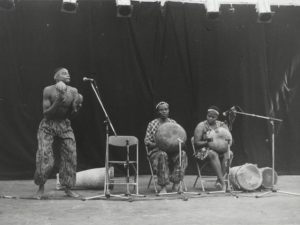The stories in this section foreground Sekuru Chigamba’s experiences during the transitional period of Zimbabwe’s liberation struggle, or Chimurenga. As Sekuru Chigamba recounts, the ancestral spirits of Guruve protected his family and village during the liberation war. At the pivotal moment of independence, Sekuru Chigamba also recalls dreaming that the great ancestral spirit known as Chaminuka delivered a prophecy that Zimbabweans would rule, rejoice, forget, and suffer in the years ahead.
After the war, Sekuru Chigamba became increasingly involved in ceremonies held to address the country’s prolonged drought, as well as its need for post-war reconciliation and healing. One of the central figures in these ceremonies was an elderly man known as Mutumwa, who served as a spiritual leaders for the Johane Masowe Wechishanu Nyenyedzi Nomwe sect. During the same time period, a government resettlement scheme enabled Sekuru Chigamba to acquire land in Rushinga, located in the northeastern region of Mount Darwin. There, he built a new rural home far from his birthplace in Guruve.
For over a decade, Sekuru Chigamba’s wife Laiza Muchenje maintained this rural home, where she raised several of the couple’s grandchildren. While Sekuru Chigamba continued to reside primarily in Highfield, both he and Ambuya Chigamba regularly moved between their rural and urban homes, illustrating the type of rural-urban connections central to much of Zimbabwean life in the 20th-century. Ambuya Chigamba later moved back to live with Sekuru Chigamba the capital city, where she resided until her death in 2007.
In the decades after independence, Sekuru Chigamba began interacting with cosmopolitan Zimbabwean cultural figures such as photographer Chicago Dzviti and ethnomusicologist Keith Goddard. He also began working with North American mbira students such as Erica Azim, founder of the the non-profit organization MBIRA. As these visits intensified, Sekuru Chigamba came into contact with figures such as BBC producer Tessa Watt, British ethnomusicologist Lucy Duran, and North American ethnomusicologists Paul Berliner and Thomas Turino. Many of Dzviti’s photographs, as well as images from Sekuru Chigamba’s trip to Rushinga with Tessa Watt and Lucy Duran, are featured in the image gallery.
In the 1990s, Sekuru Chigamba began touring internationally. As he traveled throughout Europe and North America, he emerged as one of the world’s leading mbira performers, teachers, and instrument makers. At the same time, he has actively participated in shaping Zimbabwe’s national music culture through his engagement in the National Dance Company and his teaching at the Zimbabwe College of Music.

